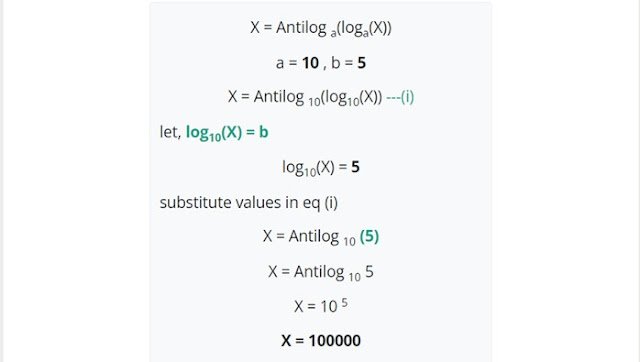What is Antilogarithm? Explained With Calculations
Antilog is an operation in mathematics that is the inverse of the logarithm. It is used to find the original value from a logarithmic result. When we take antilog of any value this case finds the result of the original value.

As they make complicated calculations involving big numbers or exponential growth simpler, logarithms are frequently employed in a variety of disciplines, including mathematics, science, economics, and data analysis. However, occasionally we need to perform the opposite operation and return the logarithmic output to its original scale.
In this article, we will discuss antilog along with its steps, examples, and application.
What is Antilog?
The antilog is the inverse operation of the logarithm, used to find the original value from a logarithmic result. It is obtained by raising a given base to the power of a logarithmic value. Numerous applications call for the employment of the antilogarithm.
It can be used to return values from logarithmic scales, such as pH or decibels, to their original units in scientific computations. It is employed in finance to determine the initial investment or asset value following the application of logarithmic adjustments.
Logbbx = x Taking the anti-log on both sides y = logbx by = blogbx by = x x=by | blogbx = x Taking the log on both sides x = by logbx = logbby logbx = y y=logbx |
Steps to find Antilog
To find the antilog of a given logarithmic value, follow these steps:
Step 1: First we identify the logarithmic value that we want to convert original scale. Let's say the symbol for a given value is "log(x)".
Step 2: Evaluate the base of logarithms: If any function base is not given we use the common logarithm base. This might be a natural logarithm in base e or a common logarithm in base 10. Denote the base as "b".
Step 3: Use the exponentiation operation to find the antilog. Raise the base (b) to the power of the logarithmic value (log(x)). It can be represented as Mathematically "b(log(x))”.
Step 4: Determine the exponentiation operation's outcome. You will receive the logarithmic value's antilog from this.
Step 5: Interpret the antilog result in the context of your problem or application. It represents the original value corresponding to the logarithmic result.
However, the fundamental concept remains the same: raising the base to the power of the logarithmic value to obtain the antilog.
Application of Antilog
The antilog is used in various applications where logarithmic transformations are involved. Here are some common applications of the antilog:
Exponential Growth and Decay:
In fields such as physics, biology, demography, and finance, decay processes or exponential growth are often modeled using logarithmic functions. We can calculate the original value involved using a function by taking antilog.
pH Scale:
pH scale is the type of logarithmic scale and pH scale is used to find the acidity or alkalinity. We can find the number of hydrogen ions (H+) or hydroxide ions (OH-) by taking antilog of pH value.
Sound and Signal Intensity:
Decibels (dB) are commonly used to express the intensity or power of sound or signals. Since decibels are expressed on a logarithmic scale, taking the antilog allows us to determine the original intensity or power levels.
Data Transformations:
In statistical analysis, logarithmic transformations are often used to address skewed distributions or stabilize variance in the data. When interpreting the results or coefficients of such transformed variables, taking the antilog provides insights into the original scale.
Financial Calculations:
Logarithmic transformations are utilized in finance to calculate rates of return or to model investment growth. The antilogarithm is then used to determine the original investment or growth rates.
Regression Analysis:
Variables in regression analysis may undergo logarithmic modifications to address non-linear correlations. The regression coefficients are then translated into terms of the original scale using the antilog.
The antilog is typically employed to translate logarithmic results back to their original scales, allowing for calculations or interpretation within the context of the original data or phenomenon.
How to calculate antilog problems?
Below are a few solved examples to learn how to calculate antilog problems.
Example 1:
Find the antilog for base 10 and the log value 5.
Solution:
Step 1:
In the first step identify the given value
Base (b) = 10
Log value = 5
Step 2:
To find the antilog we use the antilog expression
Antilog= by
Antilog = 105
Antilog = 100000
You can try an online antilog calculator by AllMath to calculate antilog of the given values quickly.

Example 2:
Given logarithmic value: 3.8792
Solution:
Step 1: The first step separates the Mantissa and Characteristic values.
Characteristic: The feature of a logarithmic value is its whole number component.
3 is the characteristic part in this example.
Mantissa: Mantissa is the decimal part of the logarithmic value.
Here,
mantissa =0.8792.
Step 2: Find the base of the logarithm. If the base is not given assume that base is 10.
Step 3: Evaluate the antilog of the mantissa.
Using a calculator or logarithmic table we can find the value of mantissa (0.8792)
Antilog of mantissa ≈7.2385.
Step 4: Determine the result of the antilog.
Add 10 raised to the power of the characteristic to the antilog of the mantissa.
antilog result = antilog mantissa × 10(characteristic)
antilog result = 7.2385 × 103 = 7238.5
Therefore, the antilog of 3.8792 is approximately 7238.5.
FAQs regarding Antilog
Q1. Discuss the method of how antilog and logarithms are connected.
Answer: Logarithms and antilogs are mathematical operations that are inversely related. The transformation that logarithms carry out is reversed by antilogs, which restore the original value from the logarithmic result.
Q2. Can the antilog be negative or zero?
Answer: The antilog can be any positive real number, including fractions or decimals. However, it cannot be negative or 0 because those numbers have undefined logarithms.
Q3. Why is the antilog important in data analysis?
Answer: The antilog is crucial for data analysis because it makes it easier to understand the outcomes of logarithmic transformations. The antilog is important for data analysis because it allows us to the interpretation of log-transform data it means if data is in log form antilog interpret into two parts, Also, the antilog facilitates the understanding of the effect of the size, used to support group comparison and aids in practical application, and making-decision based on analyzing the data.
Summary
In this article, we have discussed what is antilog, the definition of Antilog, the steps of antilog, and the application of antilog. Also, with the help of detailed examples and their solutions topic will be explained. After completely studying this article, anyone can easily defend this antilog.
